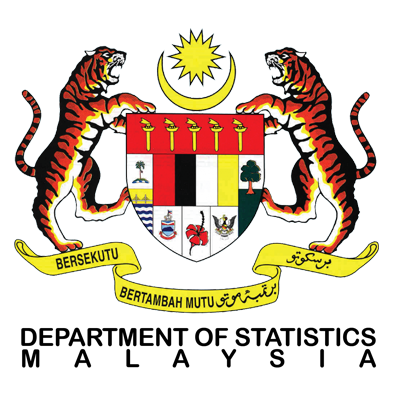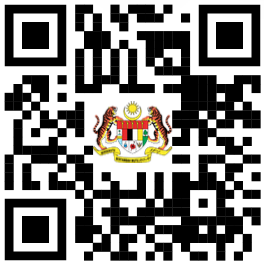Malaysia External Trade Statistics
- Home
- Statistics
- Economy
- External Sector
- Malaysia External Trade Statistics
Malaysia External Trade Statistics Jun 2019
Malaysia External Trade Statistics May 2019 3 June 2019
Malaysia External Trade Statistics April 2019 3 May 2019
Malaysia External Trade Statistics March 2019 4 April 2019
Malaysia External Trade Statistics February 2019 4 March 2019
Malaysia External Trade Statistics January 2019 30 January 2019
Malaysia External Trade Statistics December 2018 Show all release archives
Overview

KEY FACTS
MONTHLY
- Malaysia’s exports in June 2019, registered a decline of 3.1% to RM76.2 billion year-on-year (y-o-y). Re-exports was valued at RM12.2 billion registering a decrease of 22.3% y-o-y and accounted for 16.1% of total exports. However, domestic exports increased 1.7% or RM1.1 billion to RM63.9 billion.
- Imports also registered a decrease of 9.2% y-o-y to RM65.9 billion.
- On a month-on-month (m-o-m) basis, exports shrank 9.5% from RM84.1 billion. In seasonally adjusted terms, exports also decreased 6.5%.
- On a m-o-m basis, imports dropped 12.2% or RM9.2 billion from RM75.1 billion. In seasonally adjusted terms, imports decreased 9.5%.
- On a y-o-y basis, exports fell due to the decrease in exports to Hong Kong (-RM1.5 billion), China (-RM1.4 billion), Japan (-RM705.7 million) and Viet Nam (-RM463.4 million). However, exports increased to Taiwan (+RM670.9 million) and India (+RM634.0 million).
- On a y-o-y basis, lower imports were mainly from China (-RM1.9 billion), Singapore (-RM1.1 billion), Thailand (-RM1.1 billion), Taiwan (-RM635.8 million), Switzerland (-RM577.8 million) and the European Union (-RM493.4 million). Meanwhile, higher imports were from Libya (+RM286.6 million) and Angola (+RM280.3 million).
QUARTERLY
- In second quarter 2019, exports increased marginally 0.2% y-o-y to RM245.5 billion. Re-exports was valued at RM38.2 billion decreasing 26.7% y-o-y and accounted for 15.6% of total exports. Domestic exports grew 7.5% to RM207.3 billion from a year ago.
- However, imports registered a decrease of 1.2% y-o-y to RM215.3 billion.
- On a quarter-on-quarter (q-o-q) basis, exports rose 4.0% from RM236.1 billion.
- On a q-o-q basis, imports also expanded 8.1% from RM199.1 billion.
- On a y-o-y basis, the growth in exports was attributed to higher exports to India (+RM2.0 billion), the United States (+RM1.7 billion), Singapore (+RM1.3 billion), Taiwan (+RM1.2 billion) and the Philippines (+RM1.1 billion). However, exports decreased to China (-RM2.4 billion), Hong Kong (-RM1.3 billion) and the European Union (-RM1.2 billion).
- On a y-o-y basis, lower imports were mainly from Singapore (-RM2.9 billion), Switzerland (-RM1.2 billion) and China (-RM1.1 billion). Meanwhile, higher imports were from the United States (+RM1.9 billion) and Saudi Arabia (+RM878.2 million).
TRADE
Total trade which was valued at RM142.1 billion decreased RM9.1 billion or 6.0% compared to June 2018. It also posted a decline of RM17.1 billion or 10.8% when compared to May 2019. The trade surplus was RM10.3 billion, soared RM4.3 billion (+71.0%) from a year ago. It also registered an increase of 13.1% or RM1.2 billion as compared to the previous month.
EXPORTS
On a y-o-y basis, exports decreased 3.1% to RM76.2 billion. The main products which attributed to the decline were:
- Electrical and electronic (E&E) products (36.9% of total exports), shrank RM1.8 billion (-6.0%) to RM28.1 billion; and
- Timber and timber-based products, which contributed 1.9% to total exports, decreased RM305.9 million or 17.6% to RM1.4 billion.
However, the following products recorded an increase:
- Crude petroleum, which contributed 4.1% to total exports expanded RM752.2 million or 31.7% to RM3.1 billion due to the increase in both export volume (+30.6%) and average unit value (+0.8%);
- Refined petroleum products, which accounted for 7.3% of total exports, increased RM433.8 million or 8.4% to RM5.6 billion due to the increase in both average unit value (+4.5%) and export volume (+3.8%);
- Liquefied natural gas (LNG), which accounted for 3.8% of total exports grew RM151.0 million or 5.5% to RM2.9 billion due to the increase in export volume (+9.8%) as average unit value decreased 3.9%;
- Palm oil and palm oil-based products (6.6% of total exports), rose RM110.5 million (+2.2%) to RM5.0 billion. Exports of palm oil, the major commodity in this group of products increased RM206.3 million or 7.9% due to the growth in export volume (+27.4%) as average unit value decreased 15.3%; and
- Natural rubber (0.5% of total exports) increased RM33.2 million or 10.7% to RM343.5 million due to the rise in both average unit value (+6.3%) and export volume (+4.1%).
On a m-o-m basis, exports declined RM8.0 billion (-9.5%) from RM84.1 billion. The main products which contributed to the decline were:
- Electrical and electronic (E&E) products shrank RM1.3 billion (-4.3%) from RM29.3 billion;
- Palm oil and palm oil-based products declined RM1.2 billion or 19.0% from RM6.2 billion. Exports of palm oil decreased RM1.0 billion or 26.5% due to the drop in export volume (-26.6%) as average unit value increased marginally 0.1%;
- Timber and timber-based products decreased RM560.1 million (-28.2%) from RM2.0 billion;
- Refined petroleum products decreased RM448.9 million or 7.5% from RM6.0 billion due to the decline in both average unit value (-3.8%) and export volume (-3.8%);
- LNG, fell RM78.4 million (-2.6%) from RM3.0 billion due to the decrease in both export volume (-2.1%) and average unit value (-0.6%); and
- Natural rubber recorded a marginal decrease of RM9.0 million or 2.6% from RM352.5 million due to the decline in export volume (-4.1%) as average unit value rose 1.6%.
However, exports of crude petroleum increased RM645.4 million or 26.0% from RM2.5 billion due to the growth in both export volume (+24.0%) and average unit value (+1.6%).
Exports to Country of Destination
The two major destinations for Malaysia’s exports in June 2019 were Singapore and China. Exports to Singapore amounted RM10.6 billion, decreased RM92.2 million (-0.9%) as compared to the previous year.
The main product which attributed to the decline is E&E products, which contributed 42.2% of total exports dropped RM127.6 million (-2.8%) to RM4.5 billion.
Exports to China which were valued at RM10.1 billion declined RM1.4 billion (-12.0%). The main products which attributed to the decrease were:
- E&E products, which contributed 39.5% of total exports fell RM471.8 million (-10.6%) to RM4.0 billion;
- Residual petroleum products (1.9% of total exports), decreased RM463.3 million or 70.7% to RM192.3 million; and
- Copper (including alloys) which contributed 1.7% of total exports decreased RM180.7 million or 51.0% to RM173.4 million.
Seasonally Adjusted Figure
On a m-o-m basis seasonally adjusted terms, exports fell RM5.6 billion (-6.5%) to RM80.1 billion.
Exports, 2015-2019

IMPORTS
On a y-o-y basis, imports declined RM6.7 billion or 9.2% to RM65.9 billion. The decline in import was mainly attributed to capital goods, intermediate goods and consumption goods.
- Capital Goods
Imports of capital goods, which accounted for 10.9% of total imports, dropped RM2.2 billion (-23.6%) to RM7.2 billion due to the decline in both capital goods (except transport equipment) (-RM1.6 billion, -20.2%) and transport equipment, industrial (-RM583.4 million, -44.6%).
- Intermediate Goods
These goods which constituted 58.3% of total imports fell RM995.5 million (-2.5%) to RM38.4 billion. The decrease was mainly attributed to industrial supplies, processed (-RM1.8 billion, -11.3%). However, the increases were recorded for fuel & lubricants, primary (+RM517.9 million, +20.5%) and industrial supplies, primary (+RM501.2 million, +27.2%).
- Consumption Goods
Imports of consumption goods which constituted 8.5% of total imports recorded a decrease of RM318.4 million (-5.4%) to RM5.6 billion. The decrease was mainly attributed to semi-durables (-RM245.5 million, -19.6%) and durables (-RM121.9 million, -13.8%).
On a m-o-m basis, imports fell RM9.2 billion or 12.2% from RM75.1 billion. All main categories of imports by end use recorded decreases.
- Intermediate Goods
These goods fell RM4.2 billion (-10.0%) from RM42.6 billion. The main components contributed to the decrease were industrial supplies, processed (-RM3.0 billion, -17.2%), fuel & lubricants, primary (-RM884.9 million, -22.5%), and fuel & lubricants, processed, other (-RM278.4 million, -12.3%).
- Capital Goods
Imports of capital goods declined RM2.0 billion (-21.9%) from RM9.2 billion due to the decrease in both capital goods (except transport equipment) (-RM1.8 billion, -21.4%) and transport equipment, industrial (-RM255.2 million, -26.0%).
- Consumption Goods
Imports of these goods registered a decrease of RM1.1 billion (-15.9%) from RM6.6 billion. The decrease was due to food & beverages, processed, mainly for household consumption (-RM407.3 million, -21.0%), non-durables (-RM182.8 million, -11.0%), semi-durables (-RM161.8 million, -13.9%), and food & beverages, primary, mainly for household consumption (-RM147.9 million,-17.0%).
Imports by Country of Origin
The two main sources of Malaysia’s import in June 2019 were China and Singapore. Imports from China which registered RM13.4 billion shrank RM1.9 billion (-12.6%) when compared to June 2018.
The main products which attributed to the decrease were:
- E&E products, which contributed 37.9% of total imports dropped RM282.9 million or 5.3% to RM5.1 billion;
- Flat-rolled products of alloy steel (0.6% of total imports) decreased RM155.9 million (-66.2%); and
- Iron and steel bars, rods, angles, shapes and sections (including sheet piling) which constituted 0.8% of total imports declined RM143.7 million or 56.5%.
Imports from Singapore decreased RM1.1 billion (-14.3%) to RM6.9 billion from a year ago. The main products which attributed to the drop were:
- E&E products, which contributed 30.4% of total imports fell RM640.9 million (-23.4%) to RM2.1 billion; and
- Refined petroleum products (34.6% of total imports), decreased RM235.7 million or 9.0% to RM2.4 billion.
Seasonally Adjusted Figure
On a m-o-m basis seasonally adjusted terms, imports decreased RM7.1 billion (-9.5%) to RM67.0 billion.
Imports, 2015-2019

MARKET SHARE
The following charts show Malaysia's major trading partners for January - June 2019.
Total Trade by Major Countries, Jan – June 2019, percentage share

Exports and Imports by Major Countries, Jan – June 2019, percentage share
The following charts show Malaysia’s trade with ASEAN countries for January – June 2019.
Exports, Jan – June 2019, percentage share

Imports, Jan – June 2019, percentage share

#Notes:
1. The June 2019 data is provisional and subject to revision in later issues.
2. This report can be accessed through the web portal of the Department of Statistics, Malaysia (https://www.dosm.gov.my) under section: Latest Release.
Released By:
DATO' SRI DR. MOHD UZIR MAHIDIN
CHIEF STATISTICIAN MALAYSIA
DEPARTMENT OF STATISTICS, MALAYSIA
![]() DrUzir_Mahidin
DrUzir_Mahidin ![]()
![]() Dr_Uzir
Dr_Uzir
2 AUGUST 2019
Contact person:
Rohaida binti Mohamad
Public Relation Officer
Strategic Communication and International Division
Department of Statistics, Malaysia
Tel : +603-8885 7942
Fax : +603-8888 9248
Email : rohaida.mohamad[at]dosm.gov.my
Subscribe
Newsletter
Subscribe to our newsletter and stay updated
For interviews, press statement and clarification to the media, contact:
Baharudin Mohamad
Public Relation Officer
Email: baharudin[at]dosm.gov.my
Phone: 03 8090 4681
Not found what you looking for? Request data from us, through
Go to eStatistik
Email: data[at]dosm.gov.my
Phone: 03 8885 7128 (data request)










